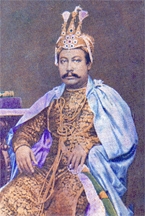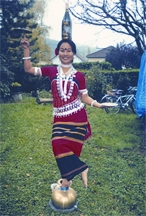Tripuris, The
Tripuris, The During the British rule Tripura was a native state maintaining internally independent status until it joined the Indian Union in 1949. The present Indian state of Tripura is considered as the main abode of ethnic Tripura or Tripuri people. In India, the inhabitants of Tripura were termed as Tripuri and the king of Tripura was known as the Manikya (ruby) king. Before the British rule in India, some parts of greater districts of Comilla, Noakhali and Sylhet, the entire Chittagong and Chittagong Hill Tracts region and Akyab province of Arakan (presently under Myanmar) were within the kingdom of Tripura for several centuries. With the grant of diwani to the east india company in 1765, the territory of Tripura state was reduced to only hilly areas of the region. After the partition of India in 1947, a remarkable segment of Tripuri population acquired citizenship of the then East Bengal consequent upon their living in the area. They live in different areas of Bangladesh including the Chittagong Hill Tracts, Sitakunda and Mirsarai upazila of Chittagong, Bilonia upazila of Noakhali district, Comilla, Chandpur, Moulavibazar, Srimangol, Rajbari and in Faridpur and Dhaka. Nearly three hundred thousands of ethnic Tripuris are now citizens of Bangladesh.

The Tripuris claim themselves as descendants of the kayastha caste, originating from the Chandra line. But anthropologically they belong to the Mongoloid race.
The mother tongue of the Tripuris is Kok-borok. It had been the state language of Independent Tripura kingdom from 585 to 1949 AD. Kok-borok had lost its state language status as the kingdom of Tripura after 1949. The old status of Kok-borok was restored on 19 January 1979 by the Government of India. Kok-borok is written in Devanagori alphabets. But some people also use Roman alphabets to write Kok-borok under the influence of the European missionaries. Kok-borok language belongs to the Tebeto Burmese branch of Asian group under the Austronesian family. The number of Kok-borok speaking people across India and Bangladesh now (2011) stand at nearly 1.9 million. The ethnic Tripuris living in Chittagong, Chittagong Hill Tracts, Noakhali, Comilla and Sylhet regions of Bangladesh, speak Kok-borok. The language widely spoken by Tripuris living in the Indian state of Tripura and Bangladesh is the main language of the South Bodo sub-group.
The social structure of Tripura nation is patriarchal. Each Tripuri family is headed by the father and in his absence the eldest son heads the family. There is an exception in some families, where female children claim superiority over the male members. They use their mothers' family titles.
Religiously the Tripuras believe in Hinduism. In the mediaeval age, Tripura was predominantly a' Hindu state. Now-a-days many Tripuras have been converted to Christianity.
The Tripuris are divided into 36 dofas or clans. These include: Gurpai, Riyang, Khali, Jomatia, Naitong, Kewa, Kema, Dendak, Gabing, Aslong, Tongpai, Anoke, Fatong, Gorjong, Khakulu, Koloi, Moksak, Muiching, Usui, Gaigra, Bery, Rukkini, Molsom, Harbang, Rangcher, Bong, Jantong, Charoi, Dampa, Mongbai, Halam, Koli, Murasing, Makhra and Maipala.

Tripurabda is the name of Tripura calendar and its abridged written form is Tring. Tripurabda is 300 years older than the Bengali calendar Bangabda and 45 years older than the Magabda. However, it is 590 years younger than the Gregorian calendar. Tripurabda was introduced officially in all northeastern Indian states in 590 AD and it was followed upto 1949 AD. The Tripuris use their traditional calendar until now. It is learnt from the Rajmala chronicle that Tripurabda was introduced in 590 AD when the great king of Tripura Birraj Hamtor Fa conquered Bengal.
Generally, the wedding ceremonies in Tripura society are solemnised in three different ways: (1) Kaijarai Kouchang or Prajapatya marriage, (2) Kaijalai Bochong or Gandharva marriage and (3) Kaijalai kusur or asura marriage. In Tripura society, wedding rituals are performed in two deferent ways, the Tantrik way and the Vedic way. In the Tantrik way of marriage offering of two worships such as Chumlai puja and Katharak puja are mandatroy. Inter-dofa marriage is allowed in their society. However, there is a bar on inter-relations marriage, where the bride and the bridegroom have blood relations for the last three generations. In the Vedic way, a priest administers the wedding ceremony and the worship of Prajapati, the god of marriage ceremony.

Feasts are arranged in Tripuri society on special occasions and the host invites the guest to join the feast through a call, termed as Nimantran (invitation). The invitation culture in the public life of Tripura is divided into two types. The first one organised to share and celebrate joyful events like wedding and birthday through a feast for seeking blessings and welfare from the guests and to infuse inspiration to others is called 'Pana'. The other invitation is referred to the feast, known as 'Samoung' organised on the occasion of tragic events, mourning and painful incidents.
Songs, dance and music are integral parts of the life, livelihood and culture of the Tripuris. Performance of dance along with vocal and instrumental music has become a mandatory ritual for marriage ceremony in folk culture of Tripura. Even, when a baby is born, the news of child-birth is announced by blowing a conch-shell. The funeral ceremony is also concluded through a performance of dance and music, both vocal and instrumental, together. Two types of funeral cremation and sraddha are practiced in Tripura society and they maintain separate crematoriums for male and female.
jhum cultivation, the traditional method of agricultural production of Tripuris, is done with the performance of music and dance. The Tripuris have a rich tradition of folk dance of which simtung, katharak, sakcharai, chumlai, kerpuja, gomoti, nairang, hachukama, sibrai, juangfa, sakal, garia, hajagiri, lebang, mamita, tripureshwari, maikhulum, haba, khum-kamoung and onjala are notable forms. Their major festivals, Baishu, Ker, Gomoti, Shibrai, Khachi and Haka are full of variation. The main festival Baishu is observed following the Tripura calendar. The elements, order, form and content of Baishu festival are fully influenced by the colour and tune of nature.
The meaning of Tripura word 'Ker' is encircling or surrounding a space. The festival of Ker worship is held on the first day of the dark fortnight in the month of Taltuk (Shravana of Shakabda). The Tripura nation regards the river Gomoti as the mother river believed to have a stream of milk. They worship the river Gomoti, also known as Tripura Sundari, daughter of the hills, on the fifth lunar day of the bright half of the moon in the month of Taltung (Jaistha of Shakabda). The Shibrai puja is offered on the 14 lunar day of the bright half of the moon in the Tal-snang month of Tripurabda (Falgoon of Shakabda). A weeklong pilgrimage fair is organised at the Fourteenth Deva Mandir in Agartala, the capital of Tripura, every year on the occasion of Khachi Puja, held on the 8th lunar day of the bright half of the moon in the month of Talung (Ashad of Shakabda). On the occasion of Haba puja, the worship of agriculture, a festival is observed in Tripura on the eve of preparing ground for cultivation.
The Tripuri women are very fond of ornaments. Some typical ornaments designed in accordance with the indigenous characteristics of Tripuri ladies are: bengki, bara, kunchi, tal, kharchi, anchli, rangvahatang, toya, wakhum, suram, sange, nake, lounk, aitam, changkhung, batang, kungbar, angta, talbatang, khanaisep etc. In the past, the males of Tripura also used to wear ornaments. Two types of funeral formalities are prevalent among the Tripuris, the cremation and sradh. Separate cremation centres are prepared for male and female deceased. [Probhangshu Tripura]
